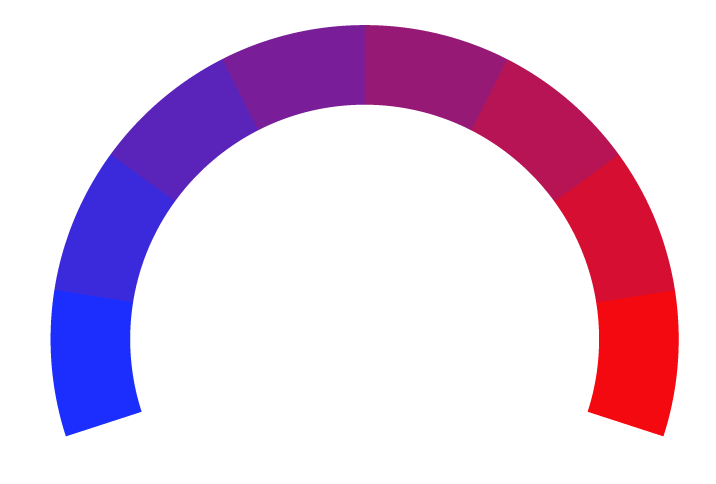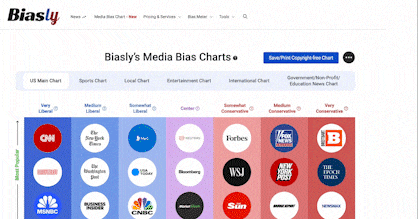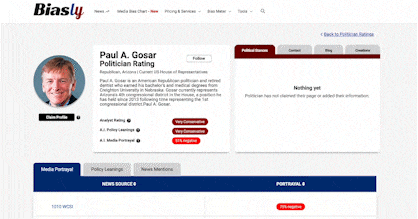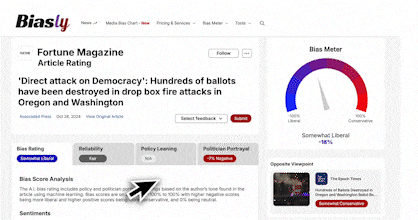House Republicans representing large shares of Medicaid, SNAP beneficiaries face tough budget test
- Bias Rating
10% Center
- Reliability
60% ReliableAverage
- Policy Leaning
10% Center
- Politician Portrayal
58% Negative
Continue For Free
Create your free account to see the in-depth bias analytics and more.
Continue
Continue
By creating an account, you agree to our Terms and Privacy Policy, and subscribe to email updates. Already a member: Log inBias Score Analysis
The A.I. bias rating includes policy and politician portrayal leanings based on the author’s tone found in the article using machine learning. Bias scores are on a scale of -100% to 100% with higher negative scores being more liberal and higher positive scores being more conservative, and 0% being neutral.
Sentiments
-16% Negative
- Liberal
- Conservative
| Sentence | Sentiment | Bias |
|---|---|---|
Unlock this feature by upgrading to the Pro plan. | ||
Reliability Score Analysis
Policy Leaning Analysis
Politician Portrayal Analysis
Bias Meter
Extremely
Liberal
Very
Liberal
Moderately
Liberal
Somewhat Liberal
Center
Somewhat Conservative
Moderately
Conservative
Very
Conservative
Extremely
Conservative
-100%
Liberal
100%
Conservative

Contributing sentiments towards policy:
58% : Census data lumps its estimates of people receiving coverage from Medicaid in with those receiving other means-tested public health coverage.54% : The lawmakers from the 10 GOP-held districts with the highest percentages of Medicaid or SNAP beneficiaries span the ideological and geographical spectrum.
54% : He represents a district with the 14th-largest share of Medicaid recipients of any Republican: 18.3% of non-elderly adults in his district rely on Medicaid or means-tested coverage as their only form of health care.
53% : But Medicaid, which had more than 72 million enrollees as of October, is far-and-away the most popular type of means-tested public health coverage.
52% : Medicaid covers health care costs for those with low incomes or disabilities, while SNAP provides food benefits to low-income Americans.
49% : Tax breaks for the rich," Senate Minority Leader Chuck Schumer, D-N.Y. told NBC News.
48% : There are a handful of House Republicans who represent parts of the country where sizable shares of the populations receive government assistance from Medicaid and the Supplemental Nutrition Assistance Program, according to an NBC News analysis of the most recently available Census Bureau data.
46% : That includes $880 billion in spending cuts from the House Energy and Commerce Committee, which has Medicaid in its jurisdiction, and $230 billion from the House Agriculture Committee, which oversees SNAP.
46% : Republicans are considering imposing work requirements and other policies that would raise the bar to access benefits for Medicaid, as well as attempting to eliminate instances of waste, fraud and abuse, in an attempt to find savings and pay for other pieces of their agenda.
43% : While Democrats represent more districts with the largest portions of adults receiving federal assistance, the prevalence of constituents who are dependent on anti-poverty programs in GOP-held seats could test Republicans who are on the hunt for steep spending cuts and under pressure to implement Trump's agenda.
40% : Valadao, who represents a key swing seat for Republicans that could determine control of the House in 2026, has been one of the loudest voices in the House GOP warning against potential cuts to Medicaid and SNAP.
34% : "And therefore, we are undecided on how we're going to be voting," she continued, referencing the GOP holdouts with concerns about Medicaid.
28% : While Trump has insisted that Medicaid won't be "touched," a Republican lawmaker on a key committee and a senior GOP aide said they believe it's mathematically difficult to achieve the goal of $2 trillion in savings without making substantial cuts to Medicaid and SNAP.
*Our bias meter rating uses data science including sentiment analysis, machine learning and our proprietary algorithm for determining biases in news articles. Bias scores are on a scale of -100% to 100% with higher negative scores being more liberal and higher positive scores being more conservative, and 0% being neutral. The rating is an independent analysis and is not affiliated nor sponsored by the news source or any other organization.

























 NBC News
NBC News


